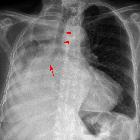inorganic dust
Inorganic dust types are derived from mineral rather than biological elements (organic compounds). Inhalation of these dusts may result in lung disease (pneumoconiosis), often after years of cumulative exposure.
The commonest inhaled dusts that cause disease are asbestos, silica and coal dust. However, the inhalation of dust or fumes from other compounds such as aluminum, beryllium, cadmium, cobalt, copper, iron, mercury, and nickel can also cause lung disease.
A wide variety of lung disease can be induced by the inhalation of inorganic dusts. These can include airway disease, lung cancer, parenchymal disease and pleural disease. Cadmium and mercury tend to induce non-specific pulmonary damage which may relate to the production of reactive oxygen species.
Metal fume fever is an inhalation fever syndrome attributed to exposure to a number of metals.
Siehe auch:
und weiter:

 Assoziationen und Differentialdiagnosen zu inorganic dust:
Assoziationen und Differentialdiagnosen zu inorganic dust:


